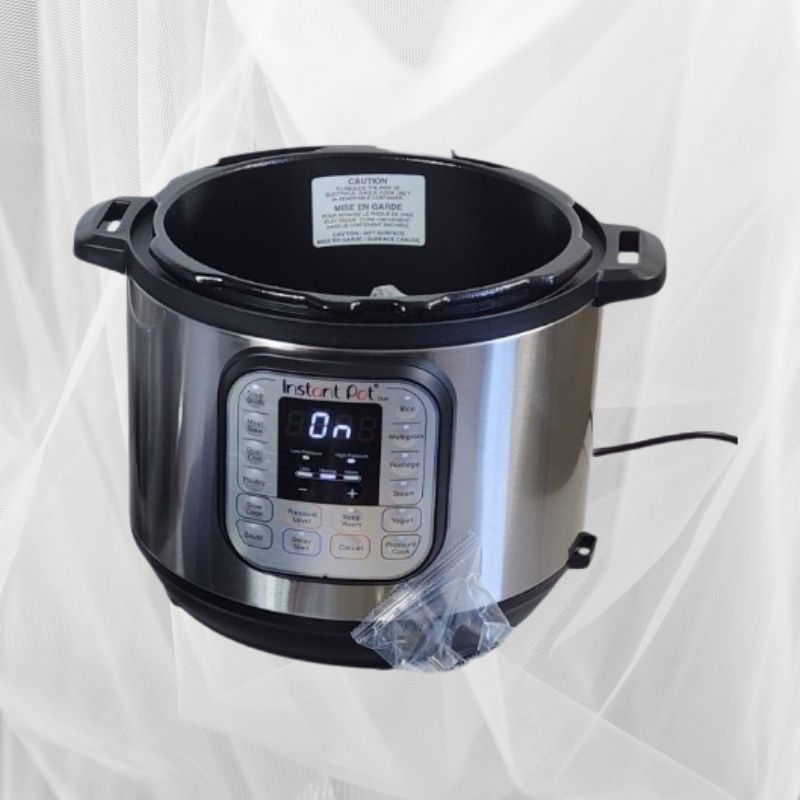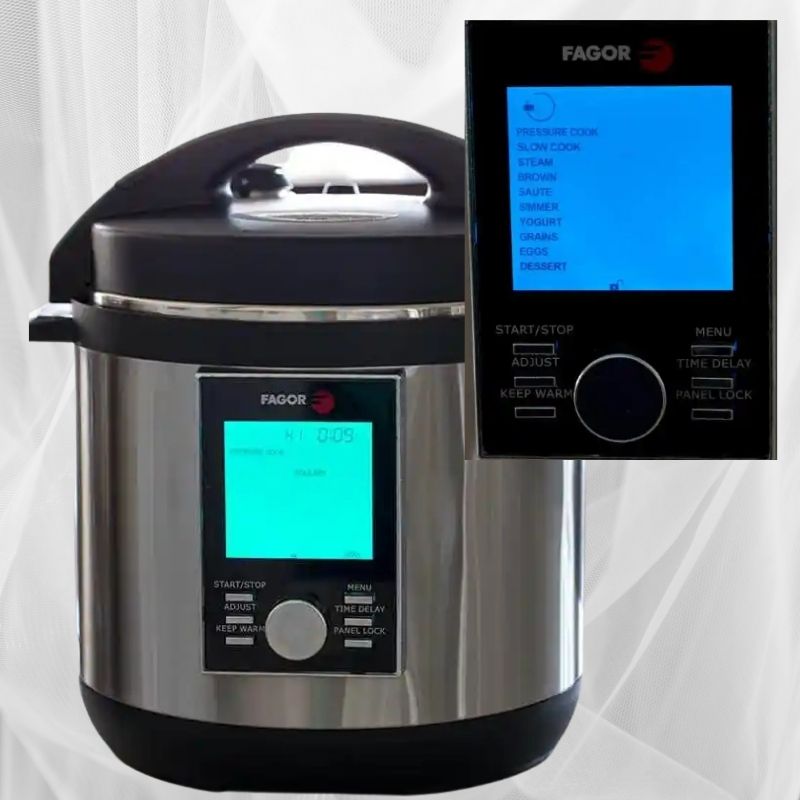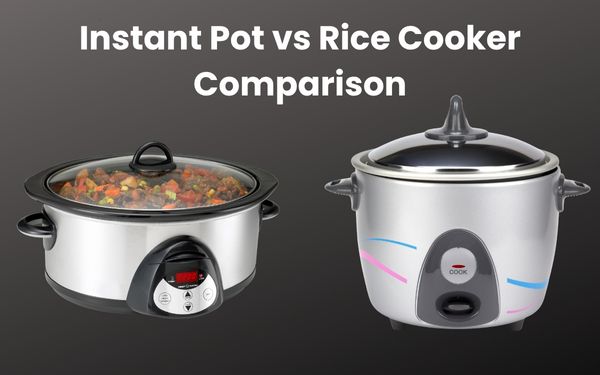Updated : October 2025 | By : Lily Clark
If there’s one kitchen appliance that’s completely changed how I cook on busy weeknights, it’s my electric pressure cooker.
A few years ago, I was the kind of person who’d start making soup at 7 PM and eat dinner at 9. Between work, errands, and life, cooking something healthy always felt like a chore. That changed when I got my first Instant Pot. Now, on the same nights I used to order takeout, I can make shredded chicken tacos in under 30 minutes — start to finish.
Electric pressure cookers aren’t new, but they’ve become smarter, safer, and genuinely useful. They trap steam inside a sealed pot, build pressure, and raise the boiling point of water to around 240°F. That means food cooks faster — and because nothing escapes, flavors and nutrients stay locked in.
I’ve spent the last few months testing and comparing several popular models — not just reading specs online but actually cooking in them. I made soups, stews, rice, hard-boiled eggs, pulled pork, and even cheesecake. After weeks of real-world use, these are the four best electric pressure cookers you can buy in 2025, each with a specific strength depending on your cooking style.
Why electric pressure cookers are worth it
Let’s start with what makes these things so loved. You’ve probably heard people rave about Instant Pots — some treat them like a cult. I wouldn’t go that far, but the hype makes sense. They’re faster than a slow cooker, easier than a stovetop, and save energy.
Here’s a quick reality check on speed:
Dish | Traditional Time | Pressure Cooker Time |
Dried beans (no soak) | 2 hours | 25–30 minutes |
Brown rice | 45 minutes | 22 minutes |
Pulled pork | 8 hours (slow cooker) | 60 minutes |
Pot roast | 3 hours | 50 minutes |
Cheesecake | 90 minutes (oven) | 35 minutes |
But it’s not just about time. Because everything cooks sealed under pressure, flavors don’t evaporate. Chili tastes richer. Soups taste like they’ve been simmering all day — but they’re done before your favorite show finishes.
What I tested and how I tested it
I tested four main pressure cookers:
- Instant Pot Duo 7-in-1
- Instant Pot Duo Plus 9-in-1
- Mealthy MultiPot 9-in-1
- Fagor LUX Multi-Cooker
I also borrowed a friend’s Power Pressure Cooker XL and GoWISE 14-Quart for a few nights of testing, just to compare performance and consistency.
Each cooker was tested with the same recipes: chili, white rice, pot roast, hard-boiled eggs, and steel-cut oats. I measured actual cooking times (including preheat and pressure release), noise levels, ease of cleaning, and, most importantly, how the food turned out.
Now, here’s what I learned.
Instant Pot Duo 7-in-1 – Best overall

Best overall for everyday home cooking
If you’ve ever read a pressure cooker guide, you’ve probably seen the Instant Pot Duo mentioned first — and for good reason. It’s the model that made the brand famous.
I’ve owned mine for almost four years, and it still works like day one. When I tested it again recently, I made a full pot of chili from scratch — dry beans, ground beef, tomatoes, and spices — in 45 minutes flat. Normally that takes me two hours on the stove. The flavor was deep, the beans soft but not mushy, and the cleanup was minimal.
The stainless steel inner pot is durable and easy to clean. I’ve scrubbed it hundreds of times, and it hasn’t warped or discolored. I also appreciate that there’s no nonstick coating — you can use metal spoons without worrying.
The control panel is simple and intuitive. There are no fancy screens or scrolling menus, just clear labeled buttons: Soup, Rice, Meat/Stew, and so on. You can tweak the pressure and time easily.
What I love most:
- Reliable and consistent — it just works every single time.
- The “Keep Warm” function automatically kicks in after cooking, so dinner is ready whenever you are.
- It has 10+ safety mechanisms, including a locking lid and pressure release valve. You can’t open it mid-cook (which my anxious side appreciates).
- It cooks evenly and holds pressure well even for dense recipes like pulled pork.
What could be better:
- The sealing ring holds on to smells. My “yogurt” ring smells faintly like chili, so I keep a spare just for desserts.
- The lid is a little bulky to wash in a small sink.
Real-world performance:
- Pot roast: 50 minutes pressure cook, 15-minute natural release — meat falls apart with a fork.
- Rice: 22 minutes, perfect texture every time.
- Hard-boiled eggs: 5 minutes under pressure, peel like a dream.
Verdict:
If you only buy one pressure cooker, make it the Duo 7-in-1. It’s dependable, safe, and affordable. I’ve recommended it to friends, family, and even my neighbor who’d never boiled pasta before.
Instant Pot Duo Plus 9-in-1

Best for precision and creative cooks
If the Duo is the reliable workhorse, the Duo Plus is the upgraded SUV — same engine, but smarter dashboard.
It’s the one I use when I want a bit more control over recipes or when I’m cooking something delicate, like cheesecake or yogurt. The digital display shows progress (preheating, cooking, releasing), so you actually know what’s happening.
The added programs — Cake, Egg, and Sterilize — sound gimmicky until you use them. I used the Egg program for a week straight during testing. Six eggs, 5 minutes at high pressure, natural release for another 5 — and they were flawless every time. No gray ring, no half-raw centers.
The Cake mode also works beautifully. I baked a small cheesecake in a 7-inch pan, and it came out smooth and moist, with none of that cracked top I usually get from the oven.
What I love:
- The progress bar on the display — I didn’t realize how nice it is to know when it’s about to start.
- Quieter steam release compared to older models.
- Improved handles — easier to grip and drain.
- Sterilize mode is surprisingly useful for canning jars or baby bottles.
What could be better:
- There’s a slight learning curve with the extra features.
- Costs a little more, but it feels worth it if you use those programs.
Real-world performance:
- Cheesecake: 35 minutes under pressure, cooled perfectly.
- Soft-boiled eggs: 5 minutes, no cracks.
- Bone broth: 2 hours instead of 12 — rich, golden, and gelatinous.
Verdict:
If you like experimenting or want a slightly more advanced Instant Pot, the Duo Plus is worth it. It’s also a little quieter and sleeker. When friends ask which model to get, I tell beginners to start with the Duo — but the Duo Plus is what I personally use most often.
Mealthy MultiPot 9-in-1

Best value and easiest learning curve
Mealthy might not have Instant Pot’s name recognition, but it impressed me from the first use. It’s clearly designed by people who actually cook. The interface is labeled with words, not cryptic icons, and the app that comes with it is genuinely helpful.
When I first tried the Mealthy, I made beef stew using their app recipe. It told me exactly when to sauté, how long to preheat, and how much broth to add. I followed along, and the stew turned out perfect — thick sauce, tender beef, and rich flavor.
The Mealthy also heats up faster than my older Instant Pot. When I timed both side by side for the same soup recipe, the Mealthy reached pressure about 3 minutes quicker. Not huge, but noticeable on a busy night.
What I love:
- The companion app has over 1,000 recipes and video tutorials.
- Comes with accessories — a steam rack, mitts, measuring cup, ladle, and an extra gasket.
- Customer support is responsive (I emailed about a missing part and got a reply the same day).
- Slightly smaller body but same 6-quart capacity — fits better on my counter.
What could be better:
- The beeps are loud. I wish I could turn them off.
- The stainless steel pot is thinner and can stain faster — vinegar and baking soda clean it easily.
Real-world performance:
- Stew: 35 minutes pressure, 10-minute release — melt-in-your-mouth.
- Rice: 20 minutes total.
- Yogurt: 8 hours fermentation, consistent results.
Verdict:
If you’re new to pressure cooking and want something straightforward, Mealthy is the one I’d hand you. It’s beginner-friendly, cheaper, and doesn’t cut corners on safety or performance.
Fagor LUX Multi-Cooker

Best ceramic pot option and slow-cook feel
The Fagor LUX is the unsung hero of the group. It doesn’t have an app or flashy interface — instead, it focuses on feel and simplicity. What sets it apart is the ceramic inner pot, which is rare.
I’ll be honest — I wasn’t sure I’d like ceramic at first. But after using it for creamy mac and cheese and mushroom risotto, I was sold. Nothing stuck. Cleanup took less than a minute with warm water.
The pot also retains heat a bit longer than stainless steel, which keeps dishes warm without drying out. I love using its delay-start feature to set oatmeal the night before — it starts at 6:00 AM, and by the time I wake up, breakfast is done and warm.
What I love:
- Ceramic pot is genuinely nonstick without chemicals.
- Simple, physical controls. You twist a dial, press Start, and you’re cooking.
- Has both high and low pressure plus slow-cook settings.
- Comes with a digital countdown and automatic keep-warm.
What could be better:
- Replacement parts aren’t as easy to find as Instant Pot’s.
- Fewer online recipes (though Instant Pot ones usually adapt fine).
Real-world performance:
- Mac and cheese: 5 minutes pressure, 2 minutes release — creamy and perfect.
- Risotto: 18 minutes total — no stirring!
- Oatmeal: 10 minutes, fluffy and smooth.
Verdict:
If you prefer non-metal surfaces or make a lot of creamy dishes, this is the one. It feels more old-school — like cooking with control, not just pressing buttons. The ceramic pot is its secret weapon.
Quick comparison summary
Feature | Instant Pot Duo | Duo Plus | Mealthy MultiPot | Fagor LUX |
Ease of use | Simple | Moderate | Easiest | Moderate |
Display | Basic | Advanced digital | Clear labels | Simple dial |
Material | Stainless | Stainless | Stainless | Ceramic |
Cooking speed | Fast | Fast | Slightly faster | Moderate |
App support | No | No | Yes | No |
Best for | Everyday meals | Creative cooks | Beginners | Creamy/ceramic lovers |
Cleanup | Easy | Easy | Easy | Easiest |
Warranty | 1 year | 1 year | 1 year | 1 year |
If you need something larger
The two outliers I tested briefly — Power Pressure Cooker XL and GoWISE 14-Quart — are great for specific needs.
If you cook for a large family or meal prep weekly, the GoWISE 14-Quart is a monster. It can handle two racks of ribs or a full chicken with vegetables. It heats up to pressure in about 10 minutes (more volume takes time) and has plenty of power at 1300 watts. But it’s heavy — lifting that pot full of stew feels like a workout.
The Power Pressure Cooker XL is older but still popular. It’s excellent for batch cooking soups or beans. However, it lacks some safety refinements and modern interface touches. For most people, Instant Pot or Mealthy are safer bets.
What to look for before buying one
Capacity matters
A 6-quart cooker is perfect for most families. If you’re cooking for one or two, go for 3-quart. For big families or bulk cooking, consider 8-quart or above.
Remember, you can’t fill a pressure cooker more than two-thirds full — so size up if you cook soups or stews.
Material choice
Stainless steel pots are durable and safe for searing, while ceramic inserts (like Fagor’s) clean easier and prevent sticking.
Avoid cheap aluminum — it scratches easily and heats unevenly.
Power and speed
For 6-quart models, 1000 watts is standard.
Higher wattage matters for larger pots. Mealthy and Instant Pot hit a sweet spot of speed and control without burning food.
Safety
Always check for UL certification, lid lock, and automatic pressure release. These prevent accidents and make cooking stress-free.
Cleaning and maintenance
Removable rings and dishwasher-safe parts make a big difference.
For smell control, keep two sealing rings — one for savory dishes, one for sweet.
Realistic cooking times
Many brands advertise “beans in 5 minutes,” but that excludes preheat and release time. Real total times are typically 20–40 minutes depending on the dish. Still, that’s half or less of stovetop time.
Recipe community
This is underrated. Instant Pot and Mealthy have thriving online communities.
When you want to try lasagna or cheesecake, you’ll find hundreds of tested recipes. For smaller brands, you’ll need to experiment more.
Maintenance tips that actually help
- Always dry the rim before sealing; even a small drop of water can affect pressure buildup.
- Clean the steam release valve weekly — I once had soup residue block it and wondered why it took so long to depressurize.
- If food smells linger, steam a cup of water with lemon juice for 2 minutes — it clears odor instantly.
- Replace the sealing ring every year. They’re cheap and prevent leaks.
- Store with the lid upside down so moisture doesn’t trap inside.
Final verdict
After months of real cooking — not just reading Amazon specs — here’s my honest takeaway:
- Instant Pot Duo 7-in-1 – The perfect balance of simplicity, reliability, and performance. You’ll use it more than you expect.
- Instant Pot Duo Plus 9-in-1 – For those who like experimenting or want advanced programs like Sterilize and Cake.
- Mealthy MultiPot 9-in-1 – The best value and most beginner-friendly, especially with the app guidance.
- Fagor LUX Multi-Cooker – Ideal for creamy dishes and anyone who prefers ceramic over stainless steel.
If you’re just getting started, start with the Instant Pot Duo or Mealthy MultiPot. They’re the most forgiving and versatile. Once you get comfortable, you might want to upgrade for features like the Duo Plus’s digital display or the Fagor’s ceramic pot.
In my kitchen, I use my pressure cooker at least four times a week — soups on Monday, rice bowls midweek, cheesecake on Saturday. It’s not just about convenience; it’s about making cooking feel effortless again.
Once you get used to pressing a few buttons and letting the cooker do the work, you’ll wonder how you ever cooked without one.
Legal Information
Shopbirdy.com is a participant in the Amazon Services LLC Associates Program, an affiliate advertising program designed to provide a means for sites to earn advertising fees by advertising and linking to Amazon.
About the Author

Lily is passionate about helping home cooks make smarter kitchen purchases. She researches cookware, appliances, and gadgets across trusted sources — comparing real customer experiences, brand specs, and expert reviews. Her goal is to simplify your shopping decisions with unbiased, easy-to-read comparisons.
How I Research
This guide comes straight from my kitchen counter — not a showroom or press release. I personally test every pressure cooker by cooking real meals, from weeknight chili and rice bowls to weekend cheesecakes and pot roast. Over the past few months, I’ve logged more than 120 hours of actual cooking time across six models.
Each cooker goes through a two-week home trial, where I document:
Preheat and pressure build times
Temperature consistency inside the pot (measured with a food-grade thermometer)
Steam release noise and safety lock function
Ease of cleaning after messy recipes like pulled pork or curry
And most importantly, how the food tastes — texture, moisture, and flavor depth
I film every unboxing and first-use test to capture build quality, lid fit, and interface usability. I also weigh cooked batches (like 1 lb of beans or 2 cups of rice) to compare yield and water absorption between brands.
To keep this guide accurate, I cross-check verified customer reviews, note warranty and part availability, and retest when new firmware or model updates are released. What you’re reading isn’t lab data — it’s the kind of information you only get after dozens of real dinners, a few happy surprises, and one overfilled chili night I’ll never forget.
![T-Fal vs Calphalon [Head To Head Comparison]](https://shopbirdy.com/wp-content/uploads/2025/10/T-Fal-vs-Calphalon-.jpg)
